Thermal desalination : structural optimization and integration in clean power and water
Author(s)
Zak, Gina Marie
DownloadFull printable version (14.16Mb)
Other Contributors
Massachusetts Institute of Technology. Dept. of Mechanical Engineering.
Advisor
Alexander Mitsos.
Terms of use
Metadata
Show full item recordAbstract
A large number of resources are dedicated to seawater desalination and will only grow as world-wide water scarcity increases. In arid areas with high temperature and salinity seawater, thermal desalination and power plants (dual-purpose/co-generation plants) are often employed for the production of power and water. In other areas, reverse osmosis is commonly employed. However, both technologies are inherently challenged with economic and performance issues. Seawater desalination methods, in particular thermal desalination methods, are highly energy intensive and are associated with CO2-emitting electricity production. This thesis is presented with three chapters, each of which is self-contained, but have a unifying goal of improving industrial-scale thermal desalination and its integration with power production or other technologies. The first chapter presents a critical review of hybrid desalination systems for cogeneration of power and water. Hybrid desalination, i.e., employing both thermal and mechanical desalination methods, is a response to the issues associated with existing seawater desalination technologies and has been increasingly utilized over thermal desalination plants alone. An overview of thermal desalination, seawater reverse osmosis, and co-generation of power and water is presented, specifically with regards to the motivation for utilizing hybrid plants, e.g., process limitations and areas of potential improvement. In addition, a review of the considerations for design and economics of hybrid desalination plants is presented, e.g., existing system configurations, thermo-economic analyses, and improvements of seawater pretreatment are discussed. Finally, studies for the optimization of hybrid desalination systems are reviewed. Specifically, the use of objective functions, continuous optimization methods, and optimal hardware configurations are discussed with respect to the key considerations of hybrid desalination plants. The purpose of the second chapter is to investigate the integration of thermal desalination methods with carbon capture and sequestration (CCS) electricity production in order to implement emissions-free thermal desalination facilities. Specifically, the Advanced Zero Emissions Plant (AZEP) oxy-combustion concept is utilized for integration in this study. The performance of several bottoming cycle integrations coupled to multi-effect distillation (MED) with and without thermal vapor compression (TVC) is estimated in order to evaluate the thermodynamic and economic feasibility of such emissions-free power and water plants. It is found that AZEP plants could utilize industry-standard dual-purpose technology and produce water near power-to-water ratios typical of dual-purpose plants without CCS. Finally, the structural optimization of thermal desalination is investigated. Many configurations of thermal desalination technologies exist, each with trade-offs in operational performance and required economic investment. Further, the optimization of hybrid or dual-purpose desalination is informed by the configuration and operation of thermal desalination as a subsystem. In this study, thermal desalination technologies are analyzed by a control volume perspective in order to identify physical processes which are shared among all technologies. A superstructure is then developed to express connectivity possibilities between these physical processes. The resulting superstructure encompasses existing thermal desalination configurations as well as the possibility for novel configurations. Informed by the superstructure, three non-standard configuration case studies are presented; the case studies demonstrate better performance with respect to performance ratio and/or specific heat transfer surface area than existing thermal desalination configurations. These studies indicate promising alternatives to standard configurations, but also identify the need for numerical optimization and detailed modeling in order to determine optimal thermal desalination structures in conjunction with dual-purpose and/or hybrid integrations.
Description
Thesis (S.M.)--Massachusetts Institute of Technology, Dept. of Mechanical Engineering, 2012. Cataloged from PDF version of thesis. Includes bibliographical references (p. 131-144).
Date issued
2012Department
Massachusetts Institute of Technology. Department of Mechanical EngineeringPublisher
Massachusetts Institute of Technology
Keywords
Mechanical Engineering.